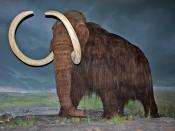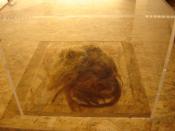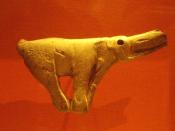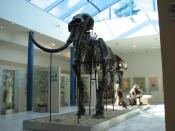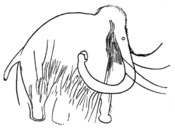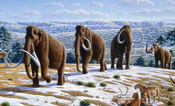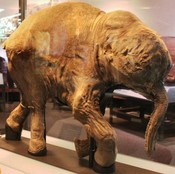The Woolly Mammoth (Mammuthus primigenius) Through my research I believe that I have come to the perfect environment for the Woolly Mammoth. To understand the Woolly Mammoth it is necessary to understand the environment in which it lived. The Woolly Mammoth lived as late as 10,000 years ago at the end of the last ice age. The woolly Mammoth was a direct descendant of the Steep Mammoth (Mammuthus trogontherii). It was unique from its other relatives, the Mastodont (Mammuthus americanum), Ancestral Mammoth (Mammuthus meridionalis), and the Columbian Mammoth (Mammuthus columbi), because of its hairy coat and its long curved tusks.
The Woolly Mammoth was better adapted to survive in the colder climates because of its long wiry hair. It lived in the northern areas of present day Siberia, Northern Europe, most of Canada, and remains have been found as far south as South Dakota. The Woolly Mammoth is one of the smaller mammoths, standing 11 feet high and weighing between 6 and 8 tons.
It is believed by many that the Woolly Mammoth was forced to the present day Dakotas by huge glaciers advancing from the north and east.
Woolly Mammoths had no natural predators except early man. This was probably not a large factor in the disappearance though. It is believed that a climate change is probably responsible for the final extinction of the woolly mammoth.
Recently an expedition to Siberia produced an almost full carcass of the Woolly Mammoth. Several scientists have wondered if the mammoth can be cloned. This is an idea most scientists believe is possible if there is a full strand of DNA recovered. There is, however, another problem with cloning the Mammoth, and that is where would the Mammoth live. It would have to be put in a Zoo, and then it would draw a lot of attention. To put the Woolly Mammoth in a zoo would require setting up an ideal environment. This would have been the environment the Woolly Mammoths lived in at the peak of the species. This environment 10-15,000 years ago was at the end of the ice age. A woolly mammoth today would have to be put in an air conditioned bubble because most climates on earth today are simply too warm. With its hairy coat it would overheat in an environment hotter than about 50 degrees. Also the Woolly Mammoth's immune system was adapted for its day. As time has progressed, so has the evolution of organisms such as bacteria. There is no way to tell if the woolly mammoth would survive something as simple as the phenomenon of bacteria. The Woolly Mammoth also ate around 700 pounds of vegetation a day. This would have to be provided in large quantity. The Woolly Mammoth was a nomadic animal and did not stay in the same place for long. Therefore, the environment that would be required would have to be quite large. Also, the mammoth would probably have to be placed with other mammoths, since Woolly Mammoths traveled in herds.
With all of this the ideal environment would be as follows: The Mammoth would have to be placed in a 200 acre climate-controlled bubble. This bubble would have to be kept free of outside bacteria and viruses and stay around 45 degrees year round. There would have to be large ferns grown in huge quantities to support the herd. In addition to the ferns, other plants must be grown. This environment must be substantially similar to the environment of the ice age so there should be no grass. In addition to the food supply grown in the environment there should be a monthly vitamin shot to ensure the mammoths health. Mammoths need a lot of food but there is no way of telling if certain bacteria of the time gave them any nutrients as a byproduct of their symbiotic relationship. The best way to have people view the mammoths would be to place several cat walks completely enclosed in a clear tube so that nothing from the people could infect the mammoths and that no trash, such as plastics, could harm them. As for the matter of light, the sun would be the best way of illuminating the bubble. Nature worked to keep these mammals alive but also worked to kill them off. Therefore, natural processes that exist within the bubble must be kept under tight surveillance. Nature would take care of cleaning the bubble because the climate- controlled ground would absorb the animal waste and use it to fertilize the ferns for future growth. The best location for this bubble would be New England because it is rocky and the ground could support the enormous weight of this structure.
In conclusion it would require much to support a woolly mammoth in this day and age. If one wants to have 1 mammoth it will be necessary to have many mammoths, and they would require a large area in which to live. In such a large area there would be many problems the mammoths would encounter for survival. With all of this I believe it would be nearly impossible to keep a mammoth in a zoo today.
Bibliography 1. Woolly Mammoth. Computer Software. Seattle: Washington Microsoft Corporation, 1996. CD-ROM.
2. Mammoth Site of Hot Springs, SD. 15 March 2000.
(15 March 2000) 3. Sutcliffe, Anthony J., On the Track of the Ice Age Mammals. Boston: Harvard University Press, 1985.
4. Burns, P. Woolly Mammoth's Suited for the Cold? 16 March 2000.
(16 March 2000) 5. Bishop, S. Woolly Mammoths Remains: Catastrophic Origins? 16 March 2000 (16 March 2000) 6. Sanford, William R, and Carl R. Green. The Woolly Mammoth. (Out of print).
